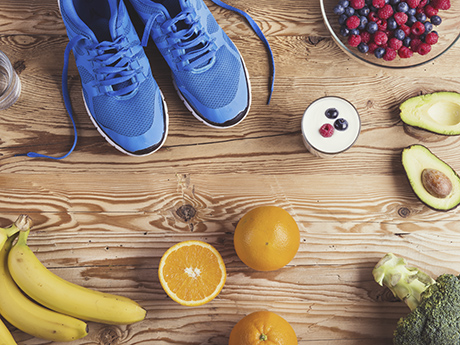Someone once asked me months ago about nutrition. That’s a big topic and many people have different views and recommendations. So just some notes and thoughts on nutrition. Our elite pro’s can ignore this article – but some of you may find it interesting and informative.
Ensuring your body has enough fuel to run and recover is instrumental. Incorporating healthy dietary practices in your training will ensure your body is ready for race day.
The body’s preferred energy source for running is glycogen, which is the body’s way of storing carbs.
Let’s take a moment to understand what’s going on in our body [engine]. Muscle cells have two primary sources of fuel: sugar and fat. Those raw materials can come from the food we eat or from storage within our own bodies.
Carbs are ‘jet fuel for muscles. Your body breaks down carbohydrates to make glucose that is burned in order to move you forward.
Why you need it: While you’re running, carbs provide you with immediate energy. That’s why sports drinks and pre-packaged fuels like gels are full of easy-to-digest carbohydrates, mostly sugar.
But sports products shouldn’t be your only source of carbs, because if you consume too many carbs at one time, your body can’t absorb them all. Instead, your body will convert those carbs into fat. That’s why runners training for long distances should also take in complex carbohydrates, such as pasta, oatmeal and potatoes, in addition to simple carbs like sugars.
Dietary carbohydrates are broken down into simple glucose, a form of sugar, which circulates in the bloodstream and powers your cells. The glucose that is not immediately needed is stored as glycogen, another form of sugar, in the muscles and liver. As you run, the body first pulls sugar from your bloodstream and then taps into the stored glycogen as glucose levels start to dip.
The other raw material that fuels your muscles, fat, is used during endurance exercise. Dietary fat must be broken down into fatty acids and other components before it can be used by the muscles, making it less immediately available than carbs and less efficient as a fuel, especially during intense exercise.
Fat
Stored body fat is an important source of energy for endurance exercise. Dietary fat helps your body absorb vitamins.
Your body, especially when it’s running long distances, needs a backup source of fuel when you’re depleted of carbs. Fats also help you feel full. Processed foods that strip out fat typically replace them with things like sugar, which leave you hungry for more.
When to eat it? Anytime, though because dietary fats are not quickly converted into fuel, a fat-rich meal isn’t a great idea right before a run.
Stored body fat, on the other hand, is an excellent fuel source because everyone — even the skinniest of runners — has so much of it. In fact, one of the best changes that happens to your body as you run regularly is that you become better able to use fat as fuel.
Food eaten far in advance of a workout will be stored as muscle glycogen, but food eaten in the hour before exercise can be used as instant fuel if the exercise intensity is low enough to still allow for digestion.
The following are examples of good complex carbohydrates: Potatoes, yams, beans, peas, wheat bread, bananas, macaroni, spaghetti, cereal, raisins, apples, bagels, syrup, brown rice, corn, apples, carrots, and root vegetables.
It is also recommended that 10 percent of runner’s diets should come from protein. This will help with muscle tissue repair.
Protein
Protein is not a fuel source, but instead it is a muscle builder or — in the case of runners — a muscle re-builder, re-shaper and re-conditioner.
As you run, you break down muscle. Protein helps your body build that muscle back in the way you need it to keep running,
Runners should also aim to consume protein within 20 minutes after a workout. Protein prolongs the period of increased insulin levels after a workout, which helps your body direct glycogen back into muscles and recover.
The following are examples of good protein sources: Low-fat milk, beans, green peas, lean beef, chicken, fish, eggs, cheese, yogurt, nuts, peanut butter, cottage cheese, tofu and soy products.
When training, 20-25 percent of your daily calories should come from unsaturated fats.
The following are examples of good unsaturated fats: Avocado, nuts, seeds, nut-butter, vegetable oil, and salmon.
Glycogen and fat are the fuel source our bodies rely on during a run. So increasing carbohydrate consumption while training and running should be encouraged. Your body’s storage of glycogen begins to decrease as you continue running and will eventually run out if not restored. Therefore, eating before, during, and after a long run is important to maintaining an adequate level of glycogen.
Fruits & Vegetables
Fruits and vegetables are other forms of carbohydrates. They contain vitamins and minerals, while also having antioxidant and anti-inflammatory benefits.
The antioxidant and anti-inflammatory properties in fruits and vegetables seem to help ease muscle soreness and limit injuries.
You can eat fruit anytime. But if you’ve had GI distress while running and/or in long races, try to limit raw fruits and vegetables 24-48 hours before a long run. (Cooked may work better for you.)
Before a run, try to eat a light snack such as a banana or wheat bagel heavy in carbohydrates. Whatever snack you choose, it should be something that your body digests well. Try out different snacks through training to see what works best for your body. It is suggested that you eat an hour before your run to ensure full digestion.
Snacks that are easier to digest (like energy gels or bars) and energy boosters are key to success during a run. Eating during a long run will help keep you moving and replenish what you’re burning. Consuming a snack loaded with complex carbohydrates is suggested every 30 to 45 minutes during activity.
After a run, your body needs to be replenished with appropriate nutrients such as carbohydrates to store glycogen and protein to help muscles recover. Always eat within 30-minutes after each run.




